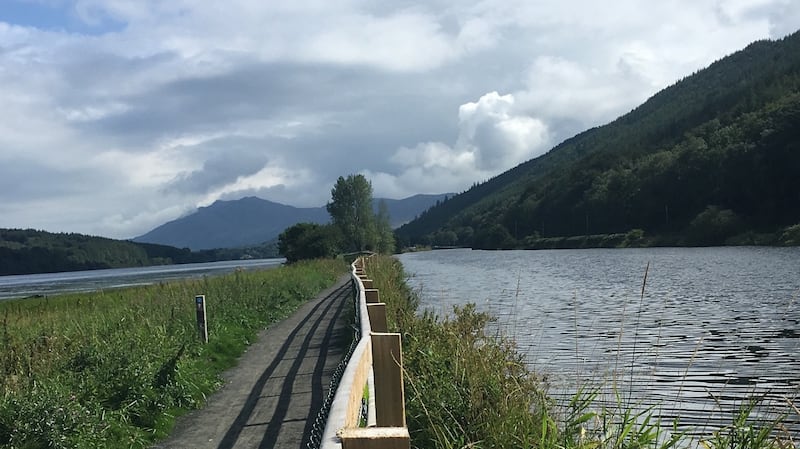I'm on my way to Warrenpoint, a small port town on the Co Down side of Carlingford Lough. This is the starting point for my walk along the Irish Border.
The bus from Newry drops me off outside the closed police station. The most recent item on the noticeboard outside dates from January 2015: an appeal for the owner of a small brown pony, seized in nearby Rostrevor, to make urgent contact with police. The building was due to be sold, and there were plans to turn it into a community centre.
But now that Brexit is imminent, the sale has been halted. According to the PSNI, this is "a precautionary step to ensure that, whatever Brexit looks like in the future, we will be able to continue to keep our communities safe."
It’s precisely the uncertainty of what Brexit will look like, particularly for Border communities like this one, that disturbs locals.
In Warrenpoint's main square, a man in a cherry picker is putting up cheerful-looking coloured bunting for a summer festival. But Bill Reilly and Jim Boylan, life-long residents of the town, are in sombre mood.
“You can see the effects of Brexit already,” says Boylan, a local businessman. “Spending has dropped, and there’s a growth in suspicion and mistrust between the communities. Weather-wise, this has been our best summer ever. But uncertainty stops people spending. And if we have a hard Brexit, it’s only going to get worse.”
No agreement
“Or if there’s no Brexit agreement at all,” adds Reilly, a retired teacher. “That’s what really puts the fear in us.”
Reports that people could be stopped, searched and even detained within a mile-wide Border zone, under planned new British legislation, have increased the sense of fear, frustration and helplessness, and reawakened grim memories of the Troubles era and its military checkpoints.
It's about uniting two communities, bringing closer economic co-operation and tourist development for the whole Carlingford Lough area
“We are living in dark times,” says Boylan. “Because of Brexit we are now seeing a reassertion of the Border that’s only going to get in the way of economic development in the Border zone. What we need is a Border enterprise zone, to improve our economic chances.”
For years, the two men have been part of a group campaigning to build a cross-Border bridge connecting Warrenpoint and Omeath, on the Co Louth side of the lough. There have been many setbacks, but Boylan and Reilly insist that the proposal for the Narrow Water bridge is still alive– and more necessary than ever.
“Co-operation, working together – that’s what the EU project was all about,” says Boylan. “The bridge will happen. It needs to happen. It’s about uniting two communities, bringing closer economic co-operation and tourist development for the whole Carlingford Lough area.”
Outside the town, walking back towards Newry, I pass the site of the proposed bridge. It would not need to be very long, with the Co Louth shore a little more than 200m away. Yet in the next year, this small inlet is due to become part of the new frontier between the United Kingdom and the European Union.
Bombs
Geography matters, in more ways than one. On August 27th, 1979, it was the close proximity of the two shorelines that allowed IRA men, hidden among the trees on the Co Louth side, to detonate two 360kg radio-controlled bombs across the Border near Narrow Water castle.
Eighteen British soldiers were killed in what was the British army’s largest single loss of members in the North during the Troubles. A young English man, who had been bird watching on the far shore, was shot dead when the army subsequently opened fire across the lough.
Nobody was ever convicted for the attack, and there is no official memorial. Instead, a series of rain-sodden wreaths are attached to a roadside fence. On a large red plastic poppy, someone has written in marker-pen: “Armagh Down Always Remembers”.
The 16th-century castle is open to the public. It is dim and dank inside with white-washed walls and a wheelie-bin parked in the corner on the cobbled floor. The guard at the entrance is unpeeling a banana.
“Where’s your yoke?” he asks me. “I don’t have one,” I reply. “I’m walking the Border – or as near to it as I can.”
He chuckles. “No yoke? Good luck to you. Nobody walks around here.”

The dual carriageway skirts the shore all the way to Newry. At Albert Basin, in the busy town, I walk through an unpromising looking gate topped with barbed wire and find myself on a recently opened stretch of the Carlingford Lough Greenway – a joint enterprise between Newry, Mourne and Down District Council and Louth County Council.
The route, which received substantial EU funding, follows the water for 5km to Victoria Lock.
Aware
Not many people seem aware of the new route, but I meet Rafal and Agatha, a Polish couple, out for the afternoon with their two young sons, picking handfuls of blackberries. They have lived in Newry since 2005 – Rafal works as a lorry driver, and Agatha is a dressmaker.
I find the Border again part of the way up a steep hill, which seems to be primarily used as an unofficial rubbish dump
Are they concerned about the effect that Brexit will have on this area?
“Not really,” says Rafal. “I don’t think it will make much difference to our lives. We know people who have arrived more recently, in the last two years, and they are more worried. But we are okay, we’re settled here, the kids have Irish passports. And anyway, what can we do? These decisions will be made in a big house somewhere in England. Nothing to do with us.”
The greenway ends at Victoria Lock, and I have no choice but to take my chances on the busy road, leaping for the grass verge every time a car tears past. I study my ordnance survey map, crosschecking with what Google maps is telling me. Surely the Border must be close? It appears to run down the middle of Carlingford Lough and then take a sharp left turn on to land somewhere about here.
First comes a large black and yellow sign by Border Communities Against Brexit – "Listen to our voices, respect our vote – no EU frontier in Ireland! ". Then, at a small stone bridge, the single white line I've been following along the road becomes a broken yellow line: it's the Border.
Across the water, I can see the grey battlements of Narrow Water castle. It was not far from here, then, that the IRA men triggered those deadly bombs.
The Border cuts right across the road and disappears into a densely wooded area, thick with brambles. I will have to take the long way around and pick it up on the other side of the woods.
At Corna Mucklagh House, I stop for a cold drink, but nobody in the bar wants to talk. They are too busy watching Monaghan v Tyrone in the All-Ireland senior football championship semi-final.
I find the Border again part of the way up a steep hill, which seems to be primarily used as an unofficial rubbish dump.
‘Warning!’
Old televisions and baby buggies litter the woods on either side of the road. Again, there’s a black and yellow sign, half-hidden by undergrowth: “Warning! If there is a hard border, this road may be closed from March 2019”. Now I’m in the UK once more. I cross the Border a third time, back into Co Louth, before I reach the Carrickdale Hotel, my resting place for the night. But from Corna Mucklagh to the Carrickdale, I do not meet a single soul. It is a long, lonely road. The guard at the castle was right: nobody seems to walk around here.
This quiet, indifferent landscape is a reminder that Brexit and its impact on the Border will eventually become the distant past too
Next morning, I set out off for Jonesborough with the Border snaking along invisibly beside me before veering off to the east. This is south Armagh now, what some people used to call “bandit country”.
I pass the Edenappa Road, where Harry Breen and Bob Buchanan, two senior RUC officers, were ambushed and murdered by an IRA gang in March 1989, as they returned from meeting gardaí in Dundalk (their killings were the subject of the Smithwick Tribunal, to which recently appointed Garda Commissioner Drew Harris gave evidence in his then PSNI role). The road gets narrower and more overgrown until it's barely more than a lane. Almost each house I pass has its own guard dog, and several of them follow, barking and snarling at my heels. The dogs are suspicious. They don't seem accustomed to passersby.
When I reach the ruins of Moyry castle, built in 1601, I sit and lean against the rough stone and survey the Moyry Pass, otherwise known as the Gap of the North: the ancient North-South route between the provinces of Ulster and Leinster. The castle was constructed to secure this once vitally important strategic passage, now a half-forgotten green dip among the hills. This quiet, indifferent landscape is a reminder that Brexit and its impact on the Border will eventually become the distant past too.
But for now, it’s the seemingly insoluble present.


















